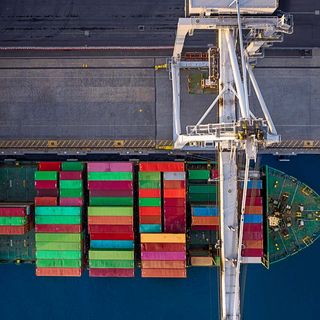Policy issues at the intersection of international security and international economics loom increasingly large for Australian and United States policymakers. Geoeconomic statecraft is the use of economic policy instruments to further geopolitical, foreign policy, and security objectives. A shift in alliance strategy towards China has reframed international and domestic economic policy settings in light of the security concerns presented by China’s growing power and influence.
China’s use of geoeconomic policy instruments has become a major concern for Australian policymakers and a focus for Australian foreign policy. Recent bilateral meetings between Australian ministers and counterparts in Japan, Singapore, India, France, South Korea, New Zealand, and the United States have all called out economic coercion as an issue of mutual concern. China’s restrictions on Australian exports during 2020 saw a reduction in exports excluding iron ore of 23 percent, at a cost of between $6.6 billion and $12 billion in export earnings, according to one estimate. These restrictions have been widely interpreted as economic punishment for foreign and other policy positions taken by the Australian government. Australian producers have been able to recoup some of these losses in other markets, but it will take time to diversify away from the Chinese market.
Recent bilateral meetings between Australian ministers and counterparts in Japan, Singapore, India, France, South Korea, New Zealand, and the United States have all called out economic coercion as an issue of mutual concern.
At the same time, the iron ore trade with China has contributed about half of the record trade surpluses Australia has recorded in recent quarters. While iron ore and liquid natural gas (LNG) exports to China have not been affected, the measures taken by China to date highlight the potential for additional economic costs to be imposed. These costs are almost certainly intended as a signal to other countries, including US alliance partners, not just the Australian government.
Geoeconomic statecraft is not new, even if it has taken on new forms in the context of the US-China rivalry. The Soviet Union broke off diplomatic relations and virtually all trade with Australia in response to the Petrov affair in 1954. Australian exports to the Soviet Union fell from $52 million, or three percent of merchandise exports, in 1953-54 to nothing by 1955-56. Australia did not recover their 1953-54 level until a decade later, yet without having to change policy in the direction sought by the Soviets. Australia and the US have often employed economic policy instruments, including economic sanctions, as part of their foreign policies.
The targeting of Australia by China raises new questions about how the US and its allies might organise and implement a collective response. Joint statements on the issue of economic coercion have already implicitly raised the threat of a collective response on the part of the US and its allies should that coercion continue or escalate. The Biden administration has said it won’t “leave Australia alone on the field.” The US, EU, Japan, and the United Kingdom have become third parties to Australia’s World Trade Organization case against China’s tariffs on Australian barley exports.
Australia and the US have increased cooperation in some geoeconomic-related policy areas, most notably on defence industry, technology, and critical minerals. The new enhanced trilateral security partnership between Australia, the United Kingdom, and the United States, AUKUS, demonstrates that the US recognises the importance of cooperation with allies in these areas. Australia’s prime minister has called for an annual economic dialogue between Australia and the US to complement the existing AUSMIN talks, with China’s economic coercion and reform of the multilateral trading system as agenda items. While Australia has sought to put geoeconomics issues on to the AUSMIN agenda, it is still an underdeveloped element in the alliance relationship. The 1951 ANZUS Treaty is silent on economic issues. The Australia-US Free Trade Agreement addresses bilateral trade and investment, but the US has largely dealt itself out of the emerging Indo-Pacific regional trade architecture represented by the Comprehensive and Progressive Trans-Pacific Partnership (CPTPP) and the Regional Comprehensive Economic Partnership (RCEP).
The Biden administration has linked any improvement in relations, including the removal of tariffs on Chinese imports, with China’s treatment of Australia, but China’s commitment to purchase US goods under President Donald Trump’s “phase one” trade deal continues to damage Australia’s interests. Domestic economic considerations increasingly inform US foreign policy, best encapsulated by the Biden Administration’s “foreign policy for the middle class.” In relation to trade policy, however, this policy isnot dissimilar to President Trump’s “America First.” The US has enormous economic assets and potential it can bring to bear in its strategic competition with China, but an inward-looking administration will face major constraints in prosecuting a geoeconomic agenda.
A geoeconomic alliance: The potential and limits of economic statecraft

The growing relevance of geoeconomic statecraft has important implications for Australian government process and policy, as well as for the Australia-US alliance. Analysts have historically underestimated the prospects for US power and influence based on geoeconomic thinking. Interrogating the analytical errors of the past should be an important element of geoeconomc policy development. However, there are also grounds for questioning whether the current US administration is well-placed to effectively implement a geoeconomic agenda given domestic political constraints.
The G7 and the Quad may be the best forums through which to address China’s economic coercion, since it is only the collective economic weight of the US, EU, and Japan that is likely to threaten China with substantial economic costs. Australia’s previous efforts to elevate the G20 as a forum for global cooperation were arguably misdirected, given the lack of common interests and values among that forum’s membership.
In terms of process, the Australian government will need to better integrate domestic and international economic policy with national security concerns. This has already occurred to some degree, but there are risks that this integration does not strike the right balance. Because national security concerns are potentially open-ended, it is very easy for these concerns to dominate policymaking processes. In particular, politicians may find it easier to default to a national security mindset rather than wrestling with difficult trade-offs. For example, the de facto Australian government ban on major Chinese cross-border acquisitions suggests that national interest concerns dominate consideration of economic benefit in the regulation of FDI.
Ensuring policy is informed by a multidisciplinary perspective is another significant challenge. Economists with knowledge and experience of foreign and defence policy represent an unusual skill set. International relations and strategic studies programs do not always provide rigorous training in economics and political economy. Cross-disciplinary training as part of public sector professional development programs should be encouraged.
Another important process issue is ensuring that an outwardly focused geoeconomic policy agenda is not captured by domestic political and policy issues. Australia’s defence industry policy has historically been captured by domestic industry and employment policy objectives, imposing resource costs that stretch the defence budget thin, undermining national security. Policymaking processes should be made more robust to domestic policy and political capture through strong project evaluation, transparency, and accountability mechanisms.
Domestic political capture is also a significant risk in the US, which could become an issue for the alliance. Alliance cooperation on industry policy, supply chain security, and critical minerals are all vulnerable to being undermined by the US domestic political process and potentially in conflict with US domestic policy objectives. The US government’s domestic policymaking is poorly coordinated and integrated with international policymaking. While Australian officials are highly effective in navigating US domestic politics, an inwardly focused administration captured by domestic policy interests is likely to be a major constraint on alliance cooperation.






